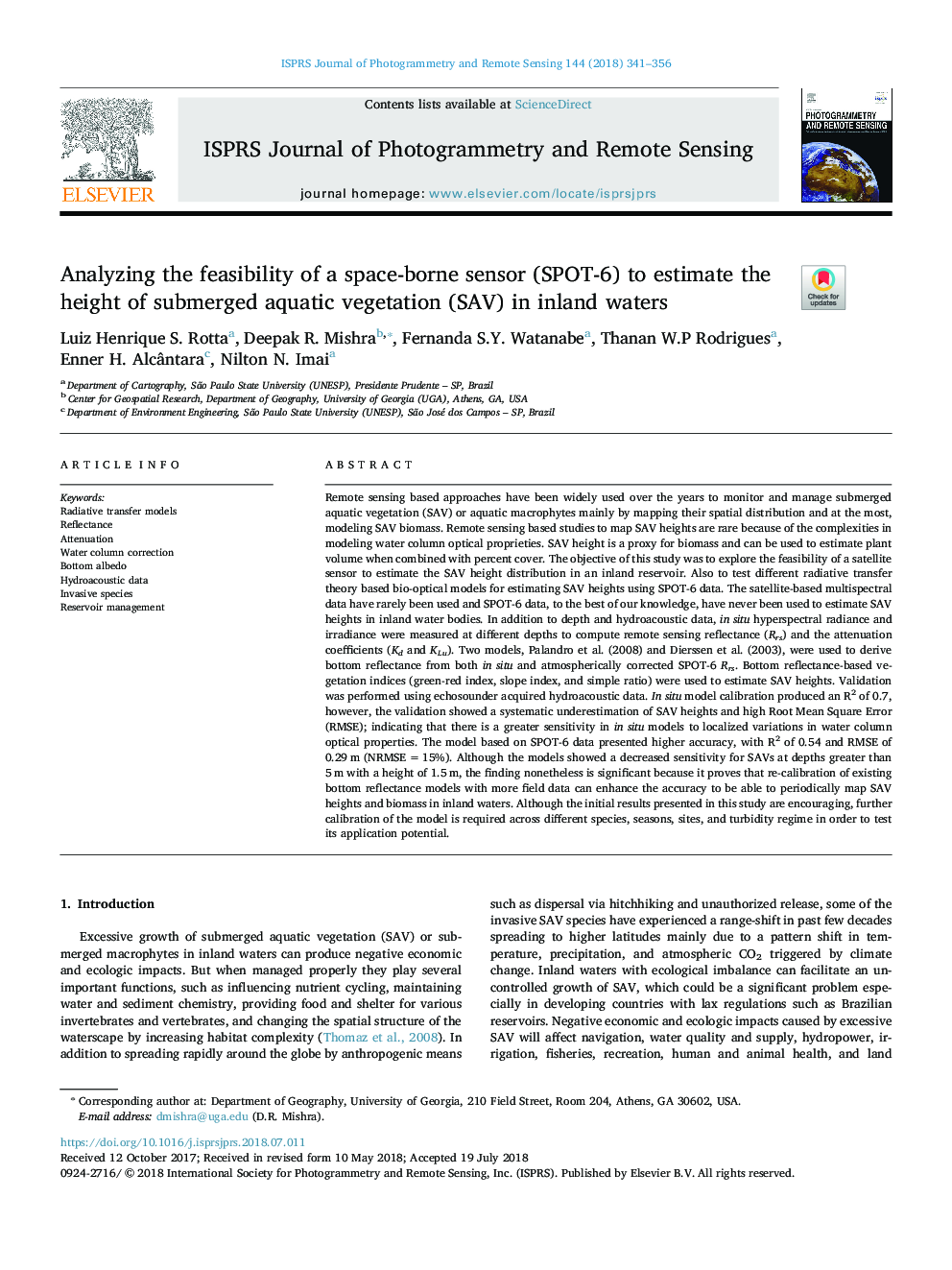| کد مقاله | کد نشریه | سال انتشار | مقاله انگلیسی | نسخه تمام متن |
|---|---|---|---|---|
| 6949045 | 1451230 | 2018 | 16 صفحه PDF | دانلود رایگان |
عنوان انگلیسی مقاله ISI
Analyzing the feasibility of a space-borne sensor (SPOT-6) to estimate the height of submerged aquatic vegetation (SAV) in inland waters
دانلود مقاله + سفارش ترجمه
دانلود مقاله ISI انگلیسی
رایگان برای ایرانیان
کلمات کلیدی
موضوعات مرتبط
مهندسی و علوم پایه
مهندسی کامپیوتر
سیستم های اطلاعاتی
پیش نمایش صفحه اول مقاله

چکیده انگلیسی
Remote sensing based approaches have been widely used over the years to monitor and manage submerged aquatic vegetation (SAV) or aquatic macrophytes mainly by mapping their spatial distribution and at the most, modeling SAV biomass. Remote sensing based studies to map SAV heights are rare because of the complexities in modeling water column optical proprieties. SAV height is a proxy for biomass and can be used to estimate plant volume when combined with percent cover. The objective of this study was to explore the feasibility of a satellite sensor to estimate the SAV height distribution in an inland reservoir. Also to test different radiative transfer theory based bio-optical models for estimating SAV heights using SPOT-6 data. The satellite-based multispectral data have rarely been used and SPOT-6 data, to the best of our knowledge, have never been used to estimate SAV heights in inland water bodies. In addition to depth and hydroacoustic data, in situ hyperspectral radiance and irradiance were measured at different depths to compute remote sensing reflectance (Rrs) and the attenuation coefficients (Kd and KLu). Two models, Palandro et al. (2008) and Dierssen et al. (2003), were used to derive bottom reflectance from both in situ and atmospherically corrected SPOT-6 Rrs. Bottom reflectance-based vegetation indices (green-red index, slope index, and simple ratio) were used to estimate SAV heights. Validation was performed using echosounder acquired hydroacoustic data. In situ model calibration produced an R2 of 0.7, however, the validation showed a systematic underestimation of SAV heights and high Root Mean Square Error (RMSE); indicating that there is a greater sensitivity in in situ models to localized variations in water column optical properties. The model based on SPOT-6 data presented higher accuracy, with R2 of 0.54 and RMSE of 0.29â¯m (NRMSEâ¯=â¯15%). Although the models showed a decreased sensitivity for SAVs at depths greater than 5â¯m with a height of 1.5â¯m, the finding nonetheless is significant because it proves that re-calibration of existing bottom reflectance models with more field data can enhance the accuracy to be able to periodically map SAV heights and biomass in inland waters. Although the initial results presented in this study are encouraging, further calibration of the model is required across different species, seasons, sites, and turbidity regime in order to test its application potential.
ناشر
Database: Elsevier - ScienceDirect (ساینس دایرکت)
Journal: ISPRS Journal of Photogrammetry and Remote Sensing - Volume 144, October 2018, Pages 341-356
Journal: ISPRS Journal of Photogrammetry and Remote Sensing - Volume 144, October 2018, Pages 341-356
نویسندگان
Luiz Henrique S. Rotta, Deepak R. Mishra, Fernanda S.Y. Watanabe, Thanan W.P Rodrigues, Enner H. Alcântara, Nilton N. Imai,